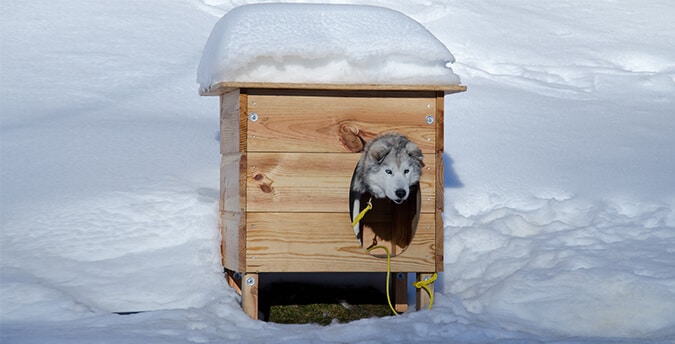How to Keep Your Dog’s House Warm Over the Winter

HOW TO KEEP YOUR DOG’S DOG HOUSE WARM OVER THE WINTER
As we near end of the year, winter sets in and surrounds us with its chilly grip. We aren’t the only ones in our households that feel the cold weather – your furry friend feels it too. If you live in a cold part of the country, it’s time to prepare your pooch for the winter season ahead.
Breeds that enjoy playing and sleeping outdoors don’t typically enjoy being in the house on cold days or evenings. The yard is their territory, and if you deny them access to it, the dog ends up feeling anxious that they’re not out patrolling the grounds.
The solution to this problem is buying them an outdoor dog house. However, when winter rolls around, the dog house can feel more like an icebox than a home for your pooch. Here are a few tips to help you warm up your furry friend’s residence when the weather turns cold.
LOCATION, LOCATION, LOCATION
Where you decide to place the structure can make a significant difference in the internal temperature of the dog house. A wind-break from the walls of your home stops chilly gusts from whipping their way into your dog’s house.
Another option is moving the doghouse into the garage, but most dogs don’t like it when you start messing around with the location of their home.
Choose a spot in your yard that receives afternoon sun. This strategy helps your dog stay warm on a cold day. However, since the coldest time of day is in the evening, leaving the dog house in a sunny spot won’t make much of a difference in the internal temperature at night time, so you might need to make some additional adjustments if your dog sleeps outdoors overnight.
KEEP THE WARMTH IN AND THE COLD OUT
Insulation is your best shot at keeping your dog warm inside their house during chilly weather. Buy a product that comes with insulated walls and floors. If your current dog house doesn’t have any insulation, do it yourself.
Purchase some drywall boards from the hardware store and cut them to fit against the internal walls and floor of the dog house. Place a layer of foam or insulation between the old walls and your new drywall. This strategy allows you to keep your dog’s body heat inside of their house, allowing them to stay warm on the coldest days.
HEAT THINGS UP
Heaters offer a practical addition to an insulated dog house. Buy a heating mat or pillow and set it up in the dog house. This strategy gives your pooch a warm bed to sleep on at night. Combined with insulated walls, a heated dog bed should suffice the needs of any dog breed.
However, in some climates, even insulated walls and a heated bed aren’t enough to keep your dog warm. If you live in the Northern States, the winters are brutal. In these conditions, your dog is likely going to need an external heater or a heated dog house to make it through the night.
Most heaters come as “plug-and-play” units that are easy to set up. Some run on a solar battery that charges during the day, while others require connection to an external power supply. Your choice of heater depends on whether or not you’re able to lay a cable to the dog house to power the heater.
Always ensure that any electrical cables are stored out of the way so that your dog doesn’t chew on or trip over them.
IN CLOSING – WINTER’S COMING
These practical solutions to heating the dog house ensure that your pooch stays warm this winter. Evaluate your dog’s needs by assessing your environment and make the necessary adjustments to the dog house before winter hits.
